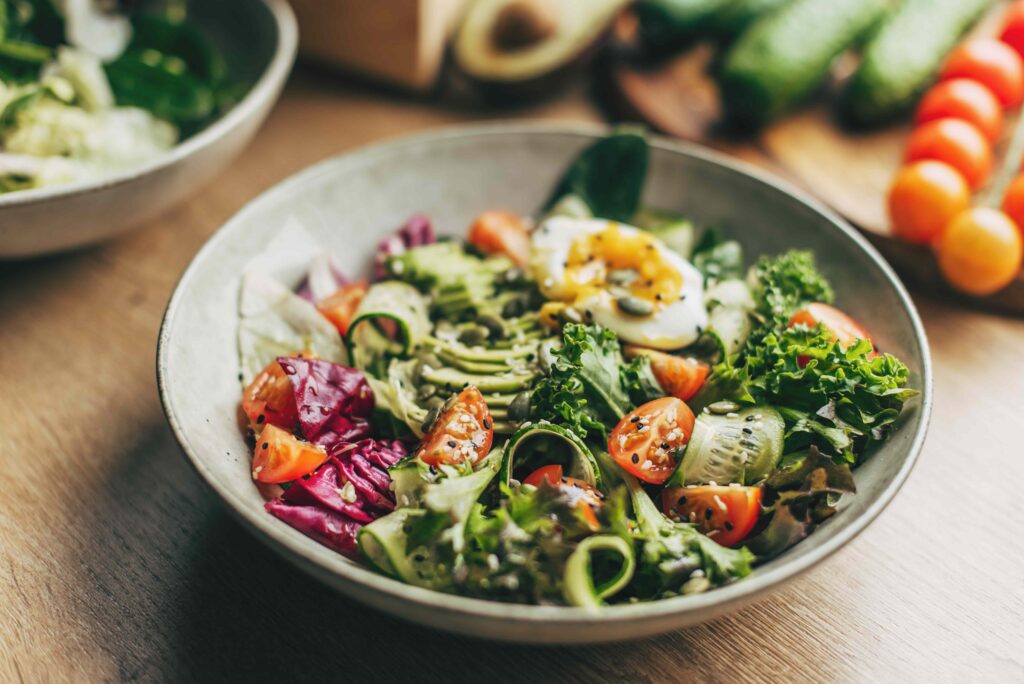Salads can either leave you hungry an hour later or power you through the rest of your afternoon.
The key to the latter? Toppings that are rich in protein, healthy fat, or quality carbohydrates such as fiber—“Think PFC for short,” Anthea Levi, MS, RD, CDN, a registered dietitian and founder of ALIVE + WELL Nutrition, told Health.
Not sure where to start? Here are nine dietitian-approved salad mix-ins that won’t have you reaching for more food right after you’re done.
Poultry and seafood make up the “P” for protein in the PFC acronym, which is why they not only support muscle growth but can also help keep you satisfied between meals, Sarah Glinski, RD, a registered dietitian in Vancouver, told Health.
Protein helps you feel full for longer, in part due to its effects on ghrelin, cholecystokinin, and glucagon-like peptide-1—hormones that regulate hunger and digestion.
Glinkski recommends a palm-sized portion of lean poultry or seafood. Good options include:
These options are also low in saturated fat, the type of dietary fat that contributes to health issues like high cholesterol, hypertension, and high blood sugar, said Levi.
Black beans, kidney beans, lentils, chickpeas, and white beans are all great additions to salads. They’re rich in both protein and carbohydrates, which can help regulate blood sugar levels and provide sustained energy throughout the day, said Glinski. They also offer a good amount of fiber.
“Certain types of fiber (like that in beans) get fermented by your gut bacteria, producing compounds that may help regulate appetite,” Glinski noted.
Not only do nuts and seeds add a tasty crunch to salads, but they also provide the “F” in PFC, offering filling, healthy fats. These poly- and monounsaturated fats can slow digestion and trigger hormones that promote satiety. What’s more, they may help lower LDL, or “bad,” cholesterol.
Experts recommended the following:
Sprinkle about a quarter cup of your favorite nuts or seeds on top of your salad, experts suggest.
Eggs pack a solid amount of protein—about 6 grams per egg—and can help ward off hunger. Studies show that, compared to meals with the same number of calories, meals that include eggs reduce food intake later on.
Plus, eggs offer complete protein, meaning they contain all nine essential amino acids. That’s “what your body needs to maintain muscle mass,” Kristen Carli, RD, a registered dietitian and owner of Camelback Nutrition & Wellness, told Health.
When it comes to adding them to salads, poached or hard-boiled eggs are popular choices.
Whole grains can provide even more fiber than vegetables, Glinski pointed out. Their high fiber content, along with the carbohydrates they contain, can help you feel full for longer.
Unlike refined grains, whole grains provide a steady release of energy—without causing a blood sugar and energy spike followed by a crash.
Glinski and Levi recommended the following:
A bit of cheese in your salad not only adds bold flavor, but the fat in varieties like Parmesan, Romano, or goat cheese also adds richness to help keep you satisfied.
Plus, “emerging research suggests that the saturated fat in dairy products may not be as detrimental to heart health as previously thought,” said Glinski.
Still, some cheeses, such as Cheddar and blue cheese, can be extra high in saturated fat and sodium, so it’s best to enjoy them in moderation.
Speaking of fat, avocado is a great source of mono- and polyunsaturated fats, said Levi. One medium avocado contains about 17 grams of monounsaturated fat, 5 grams of polyunsaturated fat (including omega-3 and omega-6), and 6 grams of saturated fat—which is OK in moderation.
These healthy fats can help you feel fuller and come with additional perks, such as regulating cholesterol levels and supporting the bacteria in your gut microbiome. They also aid your body in absorbing certain vitamins, said Glinski.
If you are a vegetarian, vegan, or simply trying to cut down on meat, edamame (aka soybeans) are a great plant-based protein that can substitute for animal products.
One cup of edamame contains about 18 grams of protein—just a few grams less than a 3-ounce chicken breast, which has around 25 grams.
A drizzle of olive oil, avocado oil, balsamic vinegar, or apple cider vinegar can help add some flavor and texture to your salad while providing you with healthy fats.
With these ingredients in mind, here’s how to build a tasty and filling salad that won’t have you reaching for those office snacks after your lunch break.
- Add as many vegetables as desired. Start with two to three cups of well-chopped leafy greens as a base, which are “great sources of a variety of vitamins, as well as antioxidants and phytonutrients,” said Glinski. Then, add as many other raw or cooked varieties as you like, said Levi. These could include arugula, spinach, peppers, hearts of palm, carrots, or roasted veggies.
- Include at least one protein. This could the foods listed above—grilled chicken, tuna, salmon, sardines, eggs, and edamame—or similar options.
- Mix in one quality grain. Look for minimally processed, high fiber options like brown rice, farro, or quinoa.
Include a healthy fat. This could come in the form of nuts, a little cheese, avocado slices, or a drizzle of olive or avocado oil. - Throw in some texture and flavor boosters. Salads should be filling, tasty, and satisfying to eat. Top them with texturized food like hemp seeds, crunchy roasted legumes, or walnuts to enhance flavor and mouthfeel.
- Limit added sugars, ultra-processed meat, and high-fat dressing. Try not to rely too heavily on sweetened or creamy dressings, ultra-processed meats like bacon bits, or candied nuts to add flavor. “These tend to pack on the calories while offering little nutritional value,” said Levi. If you’re opting for something like ranch or Caesar dressing, try putting it on the side for dipping.


